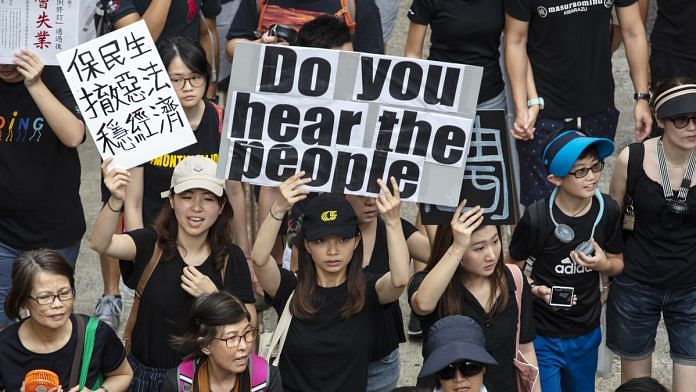New Delhi: After almost a month of mass protests, Hong Kong leader Carrie Lam this week declared that the controversial extradition Bill “is dead”.
At the forefront of the protests against the Bill were mostly Hong Kong’s students.
Young people in Hong Kong face an unemployment rate of 7 per cent. Facing low social mobility, minimal political representation and frustration over lack of democracy in the city, many students are willing to put everything on the line to fight for change.
Things weren’t always like this in Hong Kong. ThePrint takes a look at how Hong Kong reached this point.
Hong Kong has changed since 1997, so has China
When control of Hong Kong was transferred from the British to the Chinese in 1997, Hong Kong’s average per-capita income was 35 times that of China. Today, one Chinese Yuan is equal to 1.14 Hong Kong dollars.
Under the British, Hong Kong became an entry point into Asian markets for foreign investors. With its western institutions and English-proficient population, investors were comfortable doing business in Hong Kong, making it an ideal place for mainland Chinese companies to set up their international operations. As a result, Hong Kong’s economy exploded in the 1980s and 90s.
Through Hong Kong, China saw its first wave of capitalist investment and was able to import western technologies and management techniques. Because Hong Kong was so important for China’s growing economy, Beijing didn’t dare try to tamper with the “one country, two systems” arrangement that allowed Hong Kong fifty years of self-government without Beijing’s interference.
However, in the decades since the handover, many companies have started doing business directly with the mainland. China’s economy has grown substantially while income inequality has grown in Hong Kong, reaching a 45-year high in 2016. China now feels that Hong Kong’s relevance is declining as they are able to bring in capital on their own.
Also read: China and UK in diplomatic row over Hong Kong
Persistent inequality
Hong Kong has one of the largest wealth disparities in the world, with one in four children and one in three elderly people living below the poverty line.
Among ethnic minorities, Pakistanis have the highest poverty rate at 48.6 per cent while South Asians in general have a rate of 23 per cent. This is largely attributed to poor Cantonese proficiency and low school attendance.
According to Oxfam, the government could afford to spend an additional $4.7 billion on social programs to help alleviate poverty.
Hong Kong used to be a symbol of wealth and prosperity that was unattainable to mainlanders. Now, mainlanders come to Hong Kong to spend money and buy properties in the city that lie vacant for most of the year.
The recent protests emphasise the frustrations of the lower classes that have been overlooked as Hong Kong’s ultra-rich get richer. Struggling against economic disparity compounded with feelings of an encroaching Beijing, emboldened by recent economic growth, has led many to believe they have nothing left to lose.
Also read: China says Hong Kong demonstrations a challenge to ‘one country, two systems’ policy



